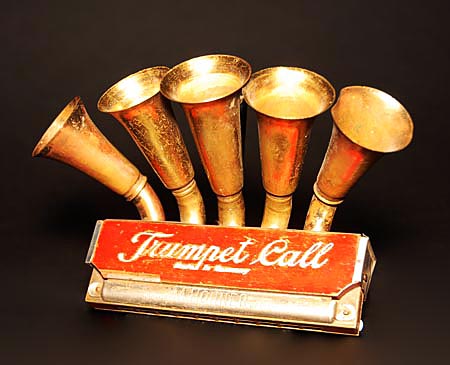
Owner: HWMC
Catalog#: CL-AEFR-16
Free Reeds
M. Hohner ‘Trumpet Call' Harmonica
Trossingen, Germany
M. Hohner
Metal, wood
ca. 1908
Length: 4.9 in; Depth: 3.5 in
Wind Instruments – Free Reeds
Inscription: Trumpet Call / Made in Germany Engraving on metal: MADE BY M. HOHNER GERMANY
This Hohner harmonica (Model 220), made during the early 20th century, is called the ‘Trumpet Call’. There is a range of harmonica types, such as diatonic, chromatic, bass, tremolo, chord, orchestral, and octave. This ‘Trumpet Call’ harmonica is of the octave type with a double row of holes and reeds. It also features five brass trumpet bells to modify its timbre, as it attracts attention.
It is played by using the mouth (lips and tongue) to direct air by blowing or drawing, into or out of the holes along a mouthpiece. Behind each hole is a chamber containing one or more reeds that are activated to vibrate by the air. Pitch is determined by the length, weight, and stiffness of the reed. Another part of the harmonica is the comb, which is the part of the body that forms chambers for the reeds. The reed plate is a grouping of reeds in a single housing that are attached to the comb. Finally, the cover plate covers the reed plates and can be made of wood and metal, and the more modern ones of plastic. They project the sound and determine the tonal quality of the harmonica.
The harmonica (mouth organ) is a free-reed aerophone. Like the Chinese free-reed sheng, they were common in East Asia since ancient times. The harmonica was first introduced to Europe by the French Jesuit Jean Joseph Marie Amiot (1718-1793), who lived in Qin-Era China. While Christian Friedrich Ludwig Buschmann is sometimes cited as the inventor of the harmonica in 1821, other inventors developed similar instruments at the same time. Then in 1829, Charles Wheatstone developed a mouthorgan under the name “Aeolina.” In 1826, German Joseph Richter was credited with inventing the blow and draw mechanism and the Richter tuning, which eventually was adopted nearly universally. Then in 1857, Matthias Hohner, a clockmaker from Trossingen, Germany, was the first to start mass-production of the harmonica and by 1868 he was supplying them to the United States. The instrument has traveled far and wide across oceans and can be found primarily in folk and popular music.
Resources: “Aeolina”. Encyclopaedia Britannica. 1 (14 ed.). 1930. p. 222.; https://en.wikipedia.org/wiki/Harmonica
